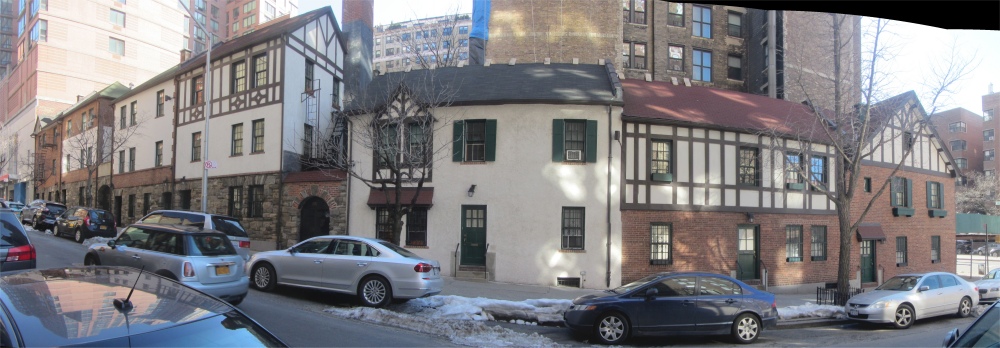
Solomon R. Guggenheim Museum
|
I caught the PATH train to 33rd Street, and on the uptown Q platform I was greeted by a melodious sound of barbershop singing wafting along the platform. It reminded me of my wife's long, happy episode of barbershop singing. Four African Americanguys, who looked as though they had just walked down off the streets, were creating a wonderful sound that echoed throughout the subterranean station. One chap was holding out a carrier bag into which people would drop notes and change as they passed by. Between songs there was a tremendous humorous banter between the guys, sharing out the collection as they excitably chatted.
I reached the Solomon R. Guggenheim Museum on Fifth Avenue, 89th Street, just opposite Central Park; the old place hadn't changed since I was last here. Solomon R. Guggenheim was born into a wealthy mining family, and founded the Yukon Gold Company in Alaska, among other business interests. He began collecting art in the 1890s, and in 1919 he retired from his business to pursue full-time art collecting.
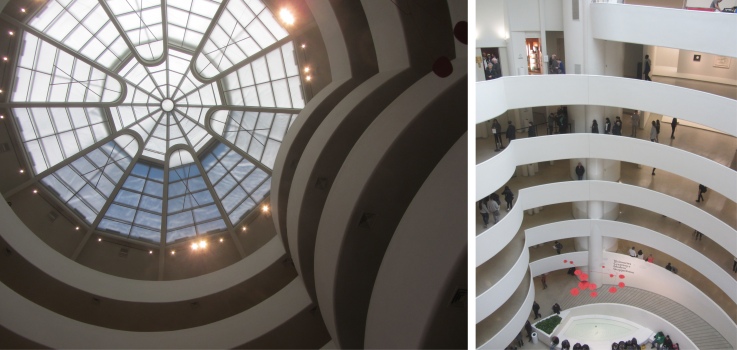
Inside the Solomon R. Guggenheim Museum
|
Eventually, under the guidance of artist Hilla von Rebay, he was introduced to the art of Kandinsky, and started to focus on the collection of modern and contemporary art, creating an important collection by the 1930s and opening his first museum in 1939, the Museum of Non-Objective Painting, at 24 East 54th Street. William Muschenheim designed the unusual gallery, decorated with pleated grey velour on the walls and thick grey carpet, and featuring recorded classical music and incense, in a former car showroom.
By the early 1940s, the museum had accumulated such a large collection of avant-garde paintings that the need for a permanent building to house the art collection had become apparent. In 1943, Guggenheim and Rebay commissioned architect Frank Lloyd Wright to design a new museum building, his only New York commission. In 1948, the collection was greatly expanded through the purchase of art dealer Karl Nierendorf's estate of some 730 objects, notably German expressionist paintings. By that time, the collection included a broad spectrum of expressionist and surrealist works, including paintings by Paul Klee, Oskar Kokoschka and Joan Miró. Guggenheim's niece, Peggy Guggenheim, who was also an ardent collector of Surrealist and abstract art, had the philosophy of collecting a new work of art each day.
Over the next 16 years, Wright made some 700 sketches and 6 separate sets of working drawings for the building. So intent was Wright on his spiral design that when told some walls would be too short for large works, he reportedly responded, "...cut the paintings in half." The construction was delayed until 1956 for various reasons, foremost among them the death of Solomon R. Guggenheim in 1949 and post-war inflation. The name of the Museum of Non-Objective Painting was changed to the Solomon R. Guggenheim Museum to distinguish it as a memorial to its founder,
The museum opened to an enthusiastic public on 21st October 1959, just six months after Frank Lloyd Wright's death. The spiral design with continuous spaces flowing freely one into another dispenses with the conventional approach to museum design, and the open rotunda affords viewers the unique possibility of seeing several areas of work on different levels simultaneously.
In 1963, Thomas M. Messer, director of the Solomon R. Guggenheim Museum, acquired a large group of works from art dealer Justin K. Thannhauser's private collection of Impressionist, Post-Impressionist, and modern French masterpieces, including important works by Paul Gauguin, Édouard Manet, and Vincent van Gogh. The collection continues to grow, with the Solomon R. Guggenheim Foundation. Today the Guggenheim is a museum in multiple locations across the globe with access to shared collections, common constituencies, and joint programming.
Thus the story of the Guggenheim Museum is essentially the story of several very different private collections. Central among these are Solomon R. Guggenheim's collection of non-objective painting premised on a belief in the spiritual dimensions of pure abstraction; his niece Peggy Guggenheim's collection of abstract and Surrealist painting and sculpture; Justin K. Thannhauser's array of Impressionist, Post-Impressionist, and early modern masterpieces; and Count Giuseppe Panza di Biumo's vast holdings of European and American Minimalist, Post-Minimalist, Environmental, and Conceptual art. These collections have been augmented over the last two decades by major gifts from The Robert Mapplethorpe Foundation and The Bohen Foundation.
To me, the building is stunning in itself. From the outside it vaguely resembles a snail's shell. Inside a continuous ramp wraps around a large atrium. On the outside wall of the ramp recesses act as small galleries in which only a fraction of the vast Guggenheim collection is displayed. The act of viewing was a continuous flow, just like the building itself. Marvellous concept!
I did the logical thing and began at the top of the ramp, and slowly worked my way down. Although not all works were to my taste, I have included here a few that attracted my attention.
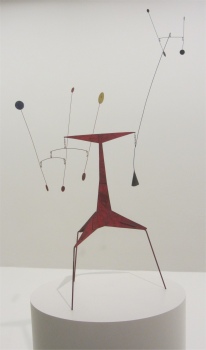
Untitled : Alexander Calder - 1942
|
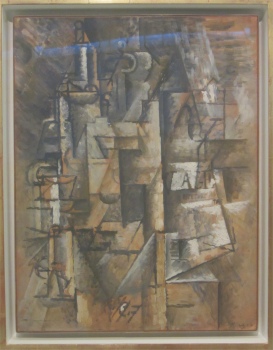
"Bottles and Glasses" : Pablo Picasso - 1911-12
|
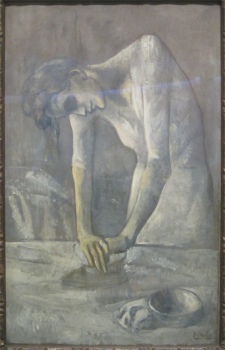
"Woman Ironing" : Pablo Picasso - 1904
|
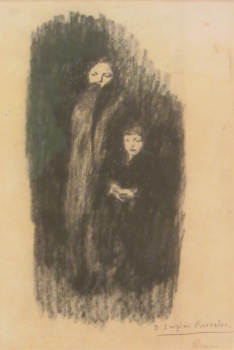
"Woman and Child" : Pablo Picasso - 1903
|

"Mountains at Saint-Rémy" : Vincent van Gogh - 1889
|

"The Hermitage at Pontoise" : Camille Pissaro - ca. 1867
|
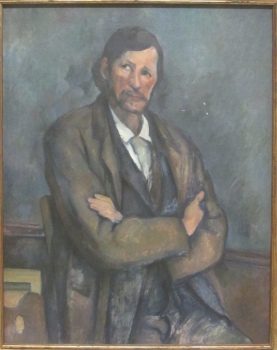
"Man with Crossed Arms" : Paul Cézanne - ca. 1899
|
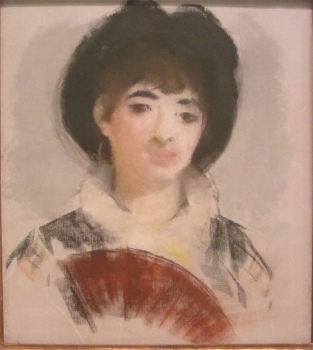
"Portrait of Countess Albazzi" : Édouard Manet - 1880
|
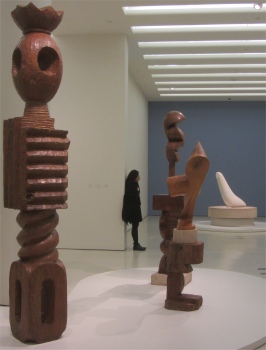
"King of Kings", "The Sorceress", "Adam and Eve",
"The Miracle (Seal [I])" : Constantin Brancusi - 1916-38
|
|
On the lower floors, offshoot rooms displayed more works of art, one room being devoted to Kandinsky.














